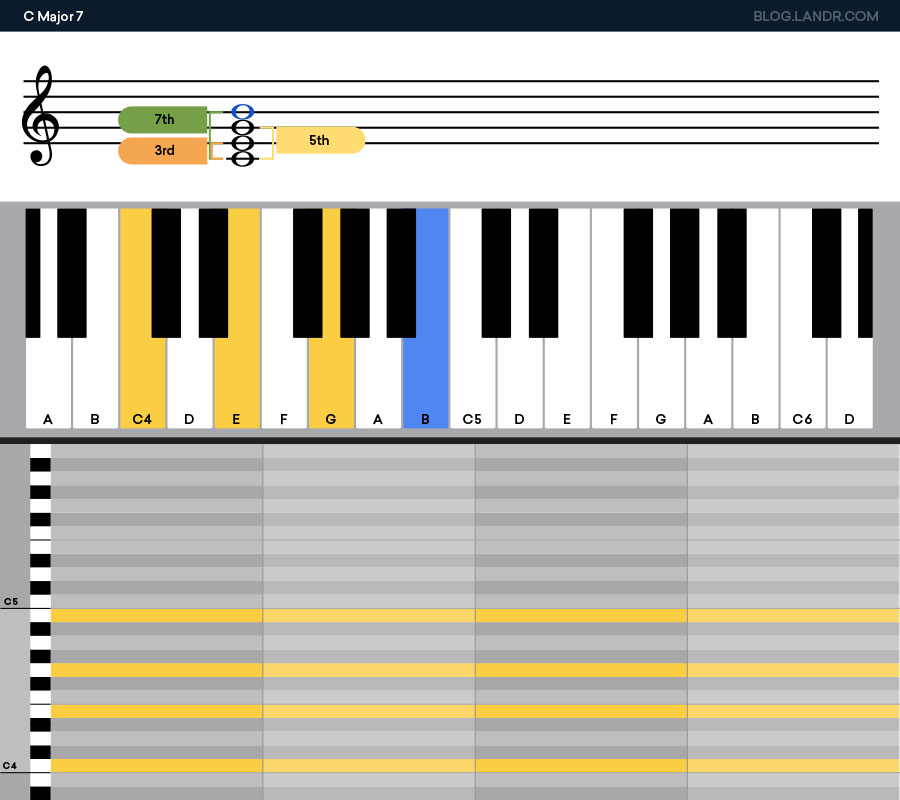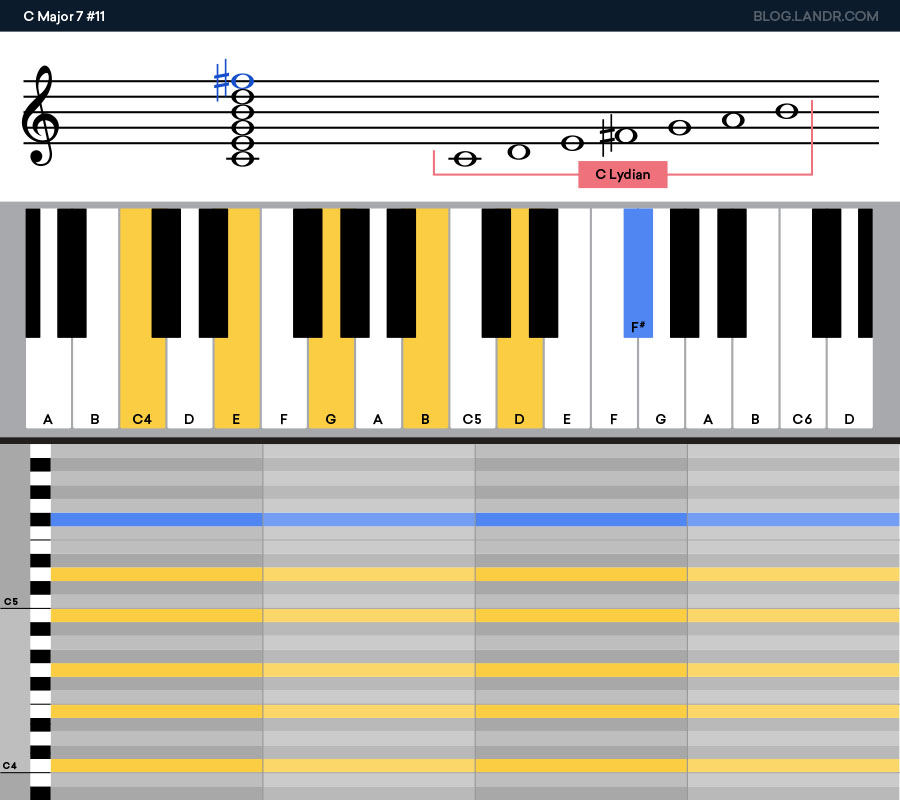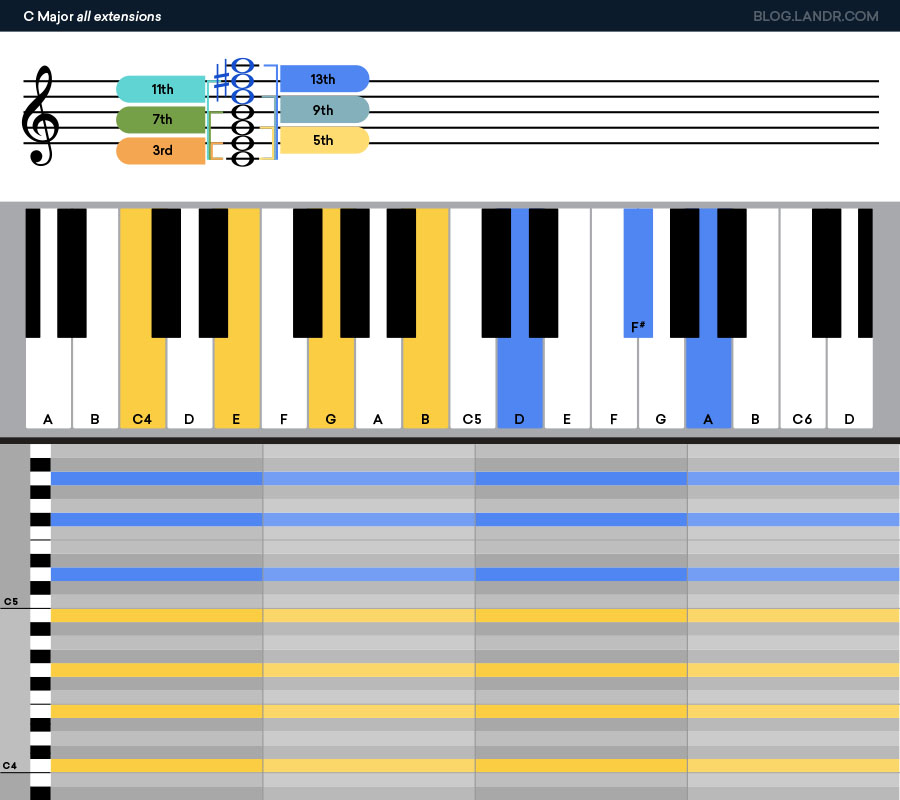Chords are the pillars that make your great songwriting. Along with rhythm and melody, harmony is one of the most basic elements of a musical composition.
The sound of your chords shows a lot about your music identity. Simple harmonic structures work just fine, however, rich chords could make a track stand out.
Including extended chords is how you bring that richness into your tracks.
In this article, I’ll teach you to build chords with extensions and show you the way to use them to take your songs beyond the triad.
What are extended chords?
Extended chords are vertical sonorities with extra color tones in addition to their basic triad of chord tones.
If that sounds complicated—don’t fear. I’m about to go over everything you should understand extensions from the ground up!
Chord construction
Including extensions begins with building chords.
The basics are pretty easy. You construct chords by stacking 3rds on top of each other. The relationship between these intervals and the root note determines the quality of the chord.
You should keep track of the scale degree and quality of each interval to identify the chord.
For instance, When you stack some thirds upon a staff, you will get a snowman:
By identifying the intervals, you understand you are taking a look at a major triad.
So far so good.
Let’s take it a step further.
When you have been practicing your ear training, you will probably know by now that some chords contain more than 3 notes.
However what notes could you add to your chord? How does it work and how will it affect your sound?
7th chords
You understand about the 4 chord qualities you could create with 3 notes. Major, minor, diminished and augmented. What occurs if you add one more to the mix?
To get began, attempt including a 3rd above the last note in your snowman:
When you evaluate the intervals of each note in relation to the root you have a major third, an ideal fifth, and a major seventh.
That identifies the chord as a major seventh.
Nonetheless, every time you change the quality of an interval, the quality of the resulting chord will also change.
When you attempt all of the combinations, that provides you:
- Major seventh
- Dominant seventh
- Minor seventh
- Half-diminished seventh
For now, I will concentrate on the first three, since they are the most commonly used.
Including these 4 note chords to your vocabulary provides us with a pretty big range of options!
More notes?
4 note chords still are not really considered extended.
Because the interval relationship of all 4 notes has an impact on the quality of the chord, we call the first 4 notes in a chord the chord tones.
However, let’s go back to the instance add another third to your snowman (which is beginning to look like more of a totem pole):
When you evaluate this note’s relationship to the tonic, the result’s different. It’s the second degree of the scale, however, an octave up.
That is the ninth. It’s the first of the extensions.
Extensions are notes that stack up as thirds on the totem pole, however, do not have the effect of changing the overall quality of the chord.
We could add those notes to a chord for color, however, their interval quality will not change the basic structure of the chord.
The resulting chord in this case? C Major 9.
Listen to the color the ninth provides the chord. There is a pleasing tension from its close proximity to both the root and the third. The chord sounds richer, however, it’s still a major seventh.
So far so good. However, there are more extensions to go!
Available extensions
For the next third you stack on to your snowman, the result is not quite the same.
Instead of richness and sophistication, this next extension provides an uncomfortable grinding dissonance. One thing in regards to the 11th you simply added doesn’t agree with the C main seventh chord.
So how will you tell which extensions to make use of? The reply lies in avoiding the dissonant quality you accidentally created.
Dissonance is a subjective term whose that means has evolved considerably throughout music history—however, here I’m talking about a very particular type of dissonance.
The rule of thumb is that including extensions that create a dissonant minor ninth interval with one of the chord tones is not allowed.
To use the 11th, we will have to alter it. The only accidental we could add to keep away from creating other minor 9ths is a sharp.
Including the sharp provides you with Cmaj7#11, a pleasantly complex sonority that appears both stable and tense at the same time.
The #11 is the same pitch class as the #4. If that’s ringing a bell, it’s because the raised fourth scale degree is the characteristic note of the Lydian mode.
In fact, when you spell out the chord with all of its extensions and write them in their easiest type, you could see that a chord with all of its extensions is made of all of the notes in the corresponding scale.
1-3-5-7-9-11-13 = 1-3-5-7-2-4-6
This is known as the chord/scale relationship. You should not memorize every single available tension when you are already familiar with the modes of the major scale.
The relationship between modes and chords tells you which extensions you could add to a chord, but also which scale to play over it while improvising. Pretty cool!
Writing with extended chords
If the large stack of thirds you just made looks clunky at this point, you are absolutely right.
In the real world, extended chords will not always contain every single possible note and they probably will not be voiced as a blocky vertical sonority.
In most cases, you will select to add just a few extensions—a 9 here or a #11 there for emphasis. To make your chords even more economical you could even omit a chord tone or two if they do not contribute to Concord. It’s up to you!
However, now that you understand the relationship between modes and extended chords, you could use extensions anywhere you might consider using the associated mode.
Here are the basics: you could think of the character of the modes like colors on a scale from light to dark.
The more raised notes that a mode contains, the “brighter” it seems. The more lowered tones, the “darker.”
It’s the same principle with chord extensions. You could instantly make a Major seventh chord sound brighter by including the #11 extension.
Or lighten up a minor chord by including the 13th—the characteristic natural sixth of the Dorian mode!
Extended techniques
Chord extensions are a useful part of your musical vocabulary. The more you incorporate them into your songwriting, the more you will hear how they could bring uniqueness to your songs.
Now that you have some ideas about the way to bring more notes into your harmony, get experimenting and see what extensions could do for your music.








